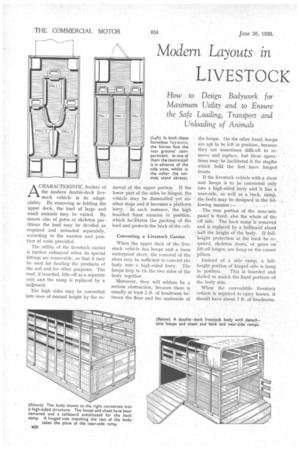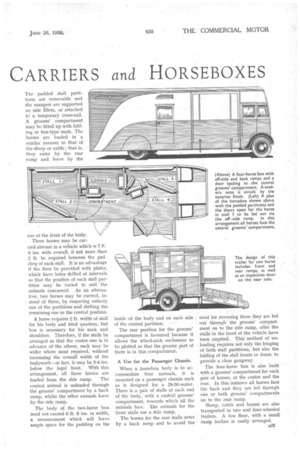Modern Layouts in
Page 68

Page 69

If you've noticed an error in this article please click here to report it so we can fix it.
LIVESTOCK
CARRIERS and HORSEBOXES How to Design Bodywork for Maximum Utility and to Ensure the Safe Loading, Transport and Unloading of Animals ACHARACTERISTIC feature of the modern double-deck livestock vehicle is its adaptability. By removing or folding the upper deck, the load of large and small animals may be varied. By meads also of gates or skeleton partitions the load may be divided as required and unloaded separately, according to the number and position of exits provided.
The utility, of the livestock carrier is further enhanced when its special fittings are removable, so that it may be used for hauling the products of the soil and for other purposes. The roof, if boarded, lifts off as a separate unit and the ramp is replaced by a tailboard.
The high sides may be converted into ones of normal height by the re
moval of the upper portion. If the lower part of the sides be hinged, the vehicle may be distnantled yet another stage and it becomes a platform lorry. In each instance, the high boarded front remain i in position, which facilitates the packing of the load and protects the back of the cab.
Converting a Livestock Carrier.
When the upper deck of the livestock vehicle has hoops and a loose waterproof sheet, the removal of the sheet may be sufficient to convert the body into a high-sided lorry. The hoops help -to tie the two sides of the body together.
Moreover, they will seldom be a serious obstruction, because there is -usually at least 5 ft. of headroom between the floor and the underside of the hoops. On the other hand, hoops are apt to be left in position, because they are sometimes difficult to remove and replace, but these operations may be facilitated if the stapes which hold the feet have hinged fronts.
If the livestock vehicle with a sheet and hoops is to be converted only into a high sided lorry and it has a near side as vt-ell as a back, ramO, .the body. may be designed in the fol
lowing manner , "
. The-rear portion of the near-side panel is fixed, also the whole of the off side. The back ramp. is removed and is .replaced by a tailboard about half the height Of the body. If fullheight protection-at the back be required, skeleton doors, or gates on lift-off hinges, are hung on the corner pillars.
Instead of a side ramp, a fullheight portion of hinged side is hung in position. This is boarded and slatted to match the fixed portions of the body side.
When the convertible livestock vehicle is required to carry horses, it should have about 7 ft. of headroom. The padded stall partitions are removable and the mangers are supported on side fillets, or attached tO a temporary cross-rail. A grooms' compartment may be fitted up with folding or box-type seats. The horses are loaded in a similar manner to that of the sheep or cattle ; that is, they enter by the rear ramp and leave by the one at the front of the body.
• Three horses may be carried abreast in a vehicle which is 7 ft. 6 ins wide overall, if not more than 2 ft. be required between the padding of each stall. It is an advantage if the floor be provided with plates, which have holes drilled at intervals so that the position of each stall partition may be varied to suit the animals concerned. As an alternative, two horses may be carried, in. stead of three, by removing entirely one of the partitions and shifting the remaining one to the central position.
A horse requires 2 ft. width of stall for his body and hind quarters, Vut less is necessary for his neck and shoulders. Therefore, if the stalls be arranged so that the centre one is in advance of the others, each may be wider where most required, without increasing the overall width of the bodywork—in fact, it may be 3-4 ins. below the legal limit. With this arrangement, all three horses are loaded from the Side ramp. The central animal is unloaded through the grooms' compartment by a back ramp, whilst the other animals leave by the side ramp.
The body of the two-horse box need not exceed 6 ft. 9 ins, in width, a measurement which will leave ample space for the-padding on the inside of the body and on each side of the central partition.
The rear position for the grooms' compartment is favoured because it allows the wheel-arch enclosures to be plotted so that the greater part of them is in this compartment.
A Use for the Passenger Chassis.
When a horsebox body is to accommodate four animals, it is mounted on a passenger chassis such as is designed for a 28-30-seater. There is a pair of stalls at each end of the body, with a central grooms' compartment, towards which all the animals face. The animals for the front stalls use a side ramp..
The horses for the rear stalls enter by a back ramp and to avoid--the
need for reversing them they are led out through the grooms' compartment on to the side ramp, after the stalls in the front of the vehicle have been emptied. This method of unloading requires not only the hinging of both stall partitions, but also the folding of the stall fronts or doors, to provide a clear gangway.
The four-horse box is also built with a grooms' compartment for each pair of horses, at the centre and the rear. In this instance all horses face the back and they are led through one or both grooms' compartments on to the rear ramp.
Sheep, cattle and horses are also transported in two and four-wheeled trailers. A low floor, with a small ramp incline is easily arranged.












































































































































